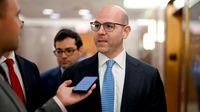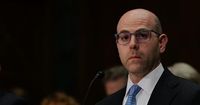In a move that has rattled the corridors of monetary policy and drawn sharp lines within the Federal Reserve, newly appointed Governor Stephen Miran has publicly pressed for aggressive interest rate cuts, arguing that the current policy stance threatens to derail America’s job market. Miran’s remarks, delivered on September 22, 2025, at the Economic Club of New York, mark his first major appearance since stepping into the role — and they’ve already sparked controversy both inside and outside the central bank.
Miran, who previously served as President Trump’s top economic adviser, was confirmed by the Senate in a razor-thin 48-47 vote just days before the Fed’s most recent policy meeting. The confirmation itself was contentious: Miran replaced Adriana Kugler, a Biden appointee who abruptly resigned, and his appointment followed Trump’s failed bid to oust Fed Governor Lisa Cook over allegations of improperly listing two properties as primary residences.
At the heart of Miran’s message is a sense of urgency. He believes the Federal Reserve’s refusal to cut rates more aggressively is a material risk to its employment mandate. "I view this policy as very restrictive and I believe it poses material risk to the Fed’s employment mandate," Miran told the assembled crowd in New York, according to a prepared text of his speech. He argued that the appropriate federal funds rate should be in the mid-2 percent range — almost two percentage points below the current policy level. "Leaving short-term interest rates roughly 2 percentage points too tight risks unnecessary layoffs and higher unemployment," he warned.
Miran’s dissent was not just philosophical. At the Fed’s meeting last week, he was the lone voice calling for a jumbo-sized, half-point rate cut, while the other 11 central bankers — including Fed Chairman Jerome Powell — settled for a more cautious quarter-point reduction. The split was clear: Miran wants to see rates end the year substantially lower, while the majority remain wary of moving too fast.
Why is Miran so convinced the Fed is behind the curve? He points to a new economic landscape shaped by Trump-era policies: reduced immigration, higher national savings rates, and deregulation. These factors, he argues, have pushed the so-called "neutral rate" — the interest rate that neither stimulates nor slows the economy — much lower than his colleagues estimate. "Including the shocks I’ve considered, I get a new real [neutral rate] that is ... near zero," Miran explained, though he cautioned that this model should be taken "seriously, not literally."
To Miran, fears of tariff-induced inflation are overblown. In an interview with CNBC, he said, "I don’t see any material inflation from tariffs," and doubled down on his belief that the risks to employment outweigh inflationary concerns. He further predicted that tariff revenues could help reduce the federal budget deficit by more than $380 billion annually over the next decade, easing upward pressure on interest rates. "Relatively small changes in some goods prices have led to what I view as unreasonable levels of concern," he said in New York.
This viewpoint stands in stark contrast to other Fed officials. St. Louis Fed President Alberto Musalem, for example, has warned that there is limited room for further rate cuts without risking an overly accommodative policy stance. "I supported the 25-basis-point reduction in the FOMC’s policy rate last week as a precautionary move intended to support the labor market at full employment and against further weakening," Musalem said during a speech at the Brookings Institution. "However, I believe there is limited room for easing further without policy becoming overly accommodative, and we should tread cautiously." Musalem pointed to persistent inflation risks stemming from tariffs and slower labor supply growth, asserting that the Fed’s primary focus should remain on bringing inflation down to its 2% target.
The tension between Miran and his colleagues highlights a fundamental divide over how best to navigate the current economic environment. While Miran contends that monetary policy is "well into restrictive territory," others see a need for caution, especially as the labor market, though softer, is not yet in crisis. As Powell noted after the latest rate decision, "The unemployment rate’s 4.3%. The economy is growing at 1.5%. So it’s not a bad economy, or anything like that. We’ve seen much more challenging economic times." Still, he acknowledged that if layoffs were to pick up, finding new employment could become much harder for affected workers.
Miran’s arrival at the Fed has also reignited debate over the independence of the central bank. With President Trump openly pressuring the Fed to slash rates and disparaging Chair Powell as "incompetent" for not moving more aggressively, critics have voiced concerns that Miran and other Trump appointees could be swayed by political considerations. Miran, for his part, insists on his independence. "I am being as transparent as I possibly can because of the concerns," he said, adding that Trump has "never asked him" to set policy in any specific way. He has taken an unpaid leave of absence from his White House role and pledged to resign from it if he continues at the Fed beyond January 2026. "I’m not going to vote for something I don’t believe in, just for the sake of creating an illusion of consensus where there is none," Miran declared.
Despite the controversy, Miran has found the Fed to be a collegial environment. "Everybody was extremely welcoming," he told CNBC, singling out even Governor Cook, who has been the subject of political attacks. Miran’s willingness to dissent — and to explain his reasoning in meticulous detail — signals that he intends to be an active and outspoken participant in the policy debate. He plans to continue relying on research from his time at the Council of Economic Advisers, but looks forward to working more closely with the Fed’s Board staff and forecasts in the coming months.
Looking ahead, Miran has indicated he would likely favor another half-point rate cut at the Fed’s next policy meeting, "as long as my current view remains." He also anticipates significant inflation relief from housing as immigration rates slow, estimating that "net zero immigration going forward would imply 1 point lower rent inflation per year." These arguments, while unconventional, are likely to keep Miran at the center of the Fed’s internal debates as the economy faces both political and economic crosswinds.
For now, the Federal Reserve finds itself at a crossroads, with Miran’s assertive stance injecting new urgency — and controversy — into the nation’s monetary policy discussions. Whether his calls for dramatic rate cuts will win over his colleagues remains to be seen, but one thing is certain: the debate over how to balance jobs, inflation, and political pressure is far from settled.

